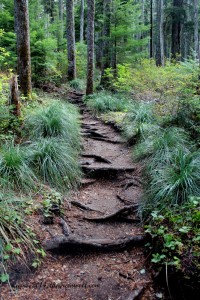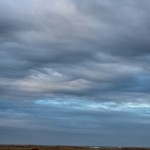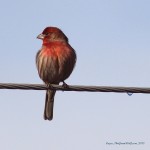It’s three o’clock on a September afternoon. I am standing on McNeil Point on the northwestern shoulder of Mt. Hood, the highest peak in Oregon. While the sun shines overhead, to my left a bed of clouds swirls and tumbles up against a deep crevice in the mountain. Here is where the Muddy Fork of the Sandy River is born, trickling down a sheer rock face from Sandy Glacier into the valley below. The roiling cloudbank hangs lower in the sky than the outcropping I’m standing on, and as the air begins to cool the clouds begin to encroach upon my sunny spot. It’s to be expected; I’m six thousand feet above sea level, and weather up here is a bit more cantankerous than in the lowlands. So I enjoy my achievement of finally making it to the stone shelter on the point, wave to the other hikers just arriving, and start to make my way back down the rocky trail before the clouds close in completely.
*******
I’ve been hiking alone for years, ever since I moved to Portland in 2007. It’s not that I don’t like hiking with other people; quite the contrary, it can be a lot of fun to explore new trails with curious people, or share some of my favorites with first-timers. But it can be a challenge to find someone in my social circle who’s willing to go out and hike ten miles on a mountainside, and on a weekday at that. Moreover, there are times when I really want to be alone, when I need the refreshment of quiet and solitude in a wild place for hours at a time, without the constant chatter of companions or the sound of other boots crushing gravel into the soil. The wilderness is my place of solace, and when what I need is introvert recharge time, taking people with me is counterproductive.
Obviously going hiking by myself isn’t as safe as going with other people. I’m not heading into the back country; most of the places I go even have some cell phone coverage (yay, elevation!) And some people worry that as a rather petite woman, I’m somehow going to invite even more danger upon myself than if I were a big, strapping manly man. Well, there’s not a whole lot I can do about the accident of my birth, but I refuse to let myself be limited by that. I refuse to live my life according to the fear that something bad might happen if I take a risk.
See, having Generalized Anxiety Disorder already colors my perceptions with an overlay of fear. It’s not a weakness; it’s a glitch in my sympathetic nervous system that sometimes causes me to respond to normal stimuli as though they were a threat, or to respond to minor challenges as major dangers. There have been times where some tiny thing has set off the anxiety, and I’ve spent hours with my body and brain reacting as though I need to run or fight or freeze, even though I know damned well there’s no real threat. Sometimes I just sit and watch this whole process unfold, waiting while my nervous system goes through the motions more appropriate to being jumped in an alley or swerving to avoid another driver. And once the offending chemicals have finally cleared out of my system, my stomach stops tying in knots, and I can think straight again, I’m exhausted from all the adrenaline and related mess. It’s really rather annoying, to be honest.
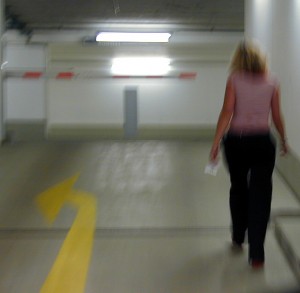
It doesn’t help that I spent my childhood being told from all directions “Don’t do that, it’s dangerous. Don’t go there, it’s dangerous” and then later “You’re a woman, you shouldn’t do that, it’s dangerous”. We’re talking perfectly normal things like exploring an open lot with interesting weeds and scraggly trees, or walking down the street of a sleepy small town suburb after dark, or walking from my car in a parking garage to a business a few blocks over. I grew up in the 80s when “stranger danger” was all the rage in the media, and served mostly to direct people away from the painful truth that the vast, vast majority of children–and adults–are hurt by people they know, not random strangers in alleyways. And as I got older I found out just how ugly victim-blaming can be when directed at survivors of sexual assault (just stay indoors! No one can hurt you if you don’t leave home, right?)
Scared children often become scared adults. Every local news channel opens up with horror stories of murders, rapes, robberies and other violent crimes, and with that cavalcade of terror hitting you at 6 and 10 every night, how can’t you be convinced the sky is falling? The fact that the vast majority of people went about their days with little issue isn’t news. And despite the fact that minorities and poor people are disproportionately more likely to be victims of violent crimes and less likely to get justice, the media latches on to every blonde haired white girl who has something bad happen to her. No wonder (as a blonde haired white girl in my youth) I was seen as the most vulnerable target by everyone around me, even though I was comparatively safe, all things told.
Years and years of that treatment tends to sink in, and it badly exacerbated my anxiety. I spent so much time being terrified something bad was going to happen to me that I never actually learned what to do when something bad did happen. The times when other people were able to hurt me–bullies at school, for example–it was because I wasn’t prepared to deal with how to deal with that situation in an effective way. I only learned to not act out, and go get help (assuming help was there), and don’t do anything that might be dangerous like stand up for myself. It took me until well into my twenties to grow a backbone (because bullies are still bullies well into adulthood), and only now in my mid-thirties do I really feel confident and strong in myself. It’s sad that it took me three decades to have that.
You know what helped me counteract all that fearmongering, even as a child? Nature. When I was younger, my little patches of woods and fields and backyards were my safe space away from all the stress I faced at school and elsewhere. And as an adult, it was through being brave in wild places–facing dark nights alone in a tent, walking a particularly challenging path–that further showed me that not every risk ended in disaster. Instead of closing myself to the possibilities of going into risky situations because “You might get hurt!”, I learned how to assess risks and mitigate the potential problems. I got the right equipment, read up on useful skills like orienteering, took several years of self-defense classes, and even got my Wilderness First Responder certification. I never go out without someone else knowing where I’m going and when I’ll be back, and I carefully research new trails before I head out on them. Being competent, and actually going out and doing things instead of staying home–these are how I have learned to fight back against anxiety and fear.
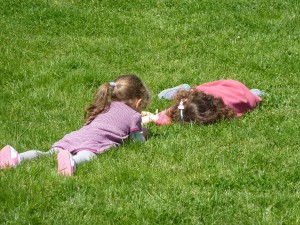
It’s not just me. Research backs up the fact that one of the many benefits nature offers is a challenging environment, good for learning and honing skills. An entire body of treatment, adventure therapy, is predicated on the concept that engaging in outdoor activities that require one to solve problems and take measured risks is good for the psyche. These experiences boost confidence and a feeling of self-efficacy, and in a group setting can help build trust and peer bonding. Even outside of organized therapy, exploring the outdoors without an agenda is good for us. It’s crucial to helping children develop curiosity, learning, and connection to the world around them, and keeps those things honed well into adulthood, to say nothing of all the physical benefits of unstructured outdoor time.
Don’t get me wrong–a little realistic fear is healthy. It helps keep one alive. That’s why I’ve done the training I have, and why I cultivate a healthy sense of self-preservation. But I’ve prepared for the wilderness the same way that I drive defensively, and I’m much more likely to die in a car accident than out in the wilderness. Risk assessment is the antidote to black and white fear-based approaches to life.
And we need that more than ever now. Thirty years ago I was still allowed to wander my neighborhood and stay out til dark (and I could still watch the fireflies in my yard at night, too) and I cultivated a deep sense of curiosity and problem-solving skills that stand me in excellent stead to this day. Now we have people calling CPS on parents whose kids play in their neighborhoods just like I used to do, and entire groups of adults who apparently are incapable of navigating Portland’s excellent transit system of buses and trains once they leave their precious gated communities to venture into the wilds of Cartlandia (which isn’t even near one of the sketchier parts of 82nd). The helicopter parents and hand-wringers of the nation are keeping their children from a really necessary part of their experience growing up, and it’s furthering the divide between us and the natural world. And it’s all because we’re too damned scared of the world around us–or, more accurately, our media-soaked perception of it. We’re terrified of any risks whatsoever.
But risk assessment is a part of who we are as humans. We evolved and developed to what we are today in part because we’re damned smart apes, and we adapt like crazy. And nature was our cradle, is still our home. We learned to walk in the African savannah, and we’ve walked all over the world since then. We didn’t let fear stop us from exploring, finding new sources for food and water and shelter and other opportunities. We had a healthy respect for the things that could eat us, but we also developed ways to defend ourselves, using tools and techniques unprecedented in this world. And now that we’ve made ourselves so safe in our temperature-controlled homes and bear-free landscapes, we’re looking too hard for things to be afraid of. In doing so we cut ourselves off from fairly innocuous experiences, and each generation retreats a little more. The soul of our species is slowly dying out.
So here’s my request to you dear readers: sometime in the next month, challenge yourself. Take yourself out of your comfort zone, even if just a little. Think of something you fear, something that’s inflated itself in your mind to a giant terror, and poke a hole in it. Challenge your perceptions that this is something you could never try. Learn more about it, not just from people who take it safe, but people who actively engage with the risks it presents and who have survived just fine. Assess for yourself the potential realistic risks (not just the media fearmongering), and instead of turning away, prepare yourself for them within your abilities and means. Then give it a shot. You might be afraid as you try, and being uncomfortable might be an unusual experience for you. Don’t let that stop you. You know the risks and how to mitigate them; let that be your compass. Whether you’re hiking alone for the first time, or just striking up a conversation with a friendly stranger at a coffee shop or book store, whether challenging yourself means exploring uncharted territory, or simply leaving your home on your own for an hour–whatever your challenge is, it’s yours and yours alone to try.
And when you’re done, whether you went as far as you planned or had to turn back because the risks were too much for now, give yourself a moment to revel in the fact that you actually went out and tried it. You engaged with the world in a way you wouldn’t normally do. You were courageous, because courage sometimes means being afraid and doing the thing anyway. In a world soaked in fear, a little courage can go a long way. Just ask me.

